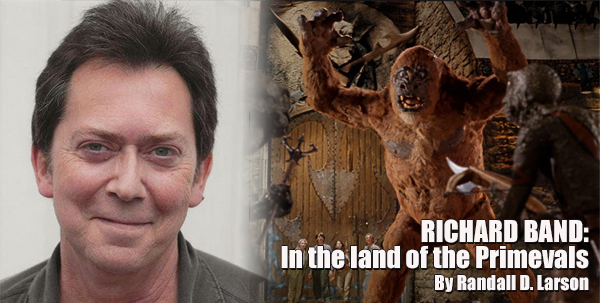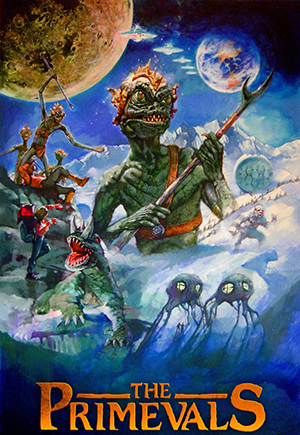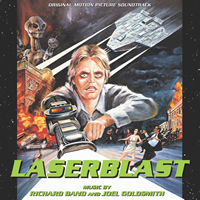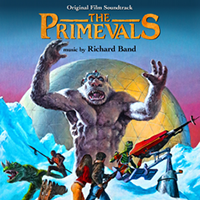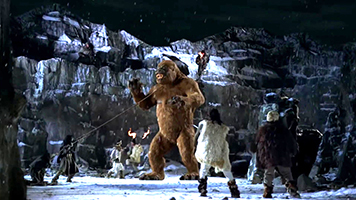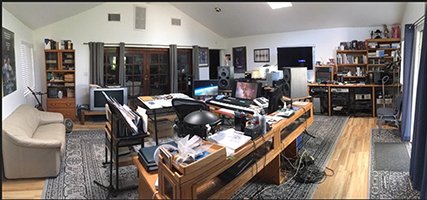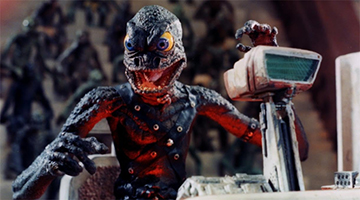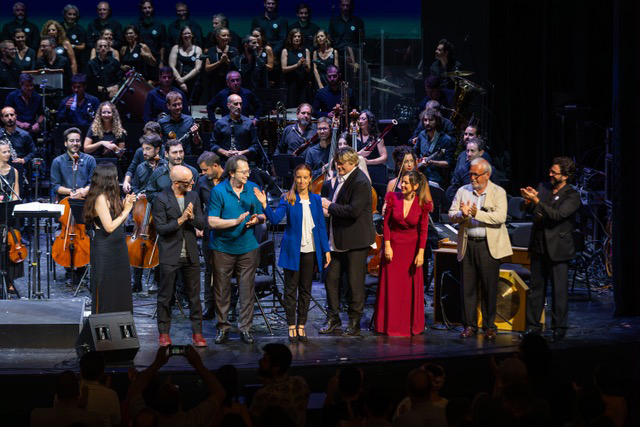
 |
||
|
Soundtrax 2024-2: Special Edition
Feature Interview:
Richard Band – In The Land of The PRIMEVALS
Interview by Randall D. Larson
THE PROJECT: Fifty years ago, filmmaker David Allen registered the story for the film that would become THE PRIMEVALS. He aimed to elevate the art of stop-motion animation into more serious, thoughtful storytelling. In the mid-1960s, the film started as an homage to Edgar Rice Burroughs, reminiscent of the fantasy films by Ray Harryhausen that impressed David as a child. Sadly, Allen died in 1999, and the film was completed by his visual effects colleague Chris Endicott.
Richard Band (LASERBLAST, THE DAY TIME ENDED, FROM BEYOND, RE-ANIMATOR, THE PUPPET MASTER series, and much more) outlines his approach to THE PRIMEVALS’ music and the inspiration that lies behind it: “I’ve always been a firm believer in the importance of themes in film scoring and this score cried out for an epic theme perhaps in the classical manner of a Steiner, Herrmann or Rozsa, or perhaps even a Goldsmith, Williams, Jarre or Shore. It was movies from my childhood, like LOST HORIZON and JASON AND THE ARGONAUTS, as well as epics like DR. ZHIVAGO and BEN-HUR, that had the import I was searching for. This film was a true joy to score and well worth the roughly 20-odd years I waited to do it.”
Watch the film’s trailer:
Q: What is your recollection of David Allen’s PRIMEVALS before coming in to score it?
Richard Band: I started seeing models he created, going back probably a year or two after I began scoring films. My first film was LASERBLAST, which I did with Joel Goldsmith – both of our first films, in 1978 – so I guess it was about a year after that. Occasionally, I would see figurines and models he was creating of the creature, as well as pictures and things like that. I’d see another model or something every six months or once a year – it dated back to not long after LASERBLAST. That’s how far back his concepts were going for the film.
Q: Of course, KING KONG was a mighty reference of Allen’s as he began creating the film using a stop-motion process back in the 70s… Is that when he started thinking about having you score the movie?
Richard Band: In fundamental terms. I guess it was in the early ‘80s, when it started becoming more of a reality, that it would happen. But at that point, I wasn’t being seriously considered to do the music. That was way, way before that. I think, when the film THE DUNGEONMASTER (1984; David Allen, Charles Band, John Carl Buechler) was made, I went to England, and I recorded about five or six cues on the back on another score I was doing – I think I was doing the score for MUTANT (1984). We recorded that with the National Philharmonic Orchestra in London. I’d arranged to do a couple of extra hours and brought four or five cues that I was going to do for THE DUNGEONMASTER, which I was starting to do then. It had four or five cool sequences; I wanted to do those with a decent-sized orchestra. Of course, they appeared in the film when it was released. After THE DUNGEONMASTER was completed and these four or five big orchestral cues were put in, David became very impressed with the overall sound and felt it should fit into PRIMEVALS. One or two of the cues had a very like Bernard Herrmann-esque take off, so he started thinking about it more in those terms, so I think at that point, going back to just after DUNGEONMASTER, is when I was more seriously considered to do the music for PRIMEVALS. And, of course, on DUNGEONMASTER, David had done a bunch of the animation in those sequences, so that was the connection.
Q: That said, what can you tell me about generating the musical environment, characters, and situations of THE PRIMEVALS as they stand now?
Richard Band: Obviously, it was a massive project – the film, needless to say, decades in the making, with all the ups and downs of it shutting down, starting up, David dying in August 1999, it being picked up by his protégé, Chris Endicott. So, the history of the movie, which will also be coming out as a separate documentary in the next few months, is a whole movie until itself! After all these years, about a year-and-a-half ago, it finally got to the point where there was an actual cut, and I could start working on it. Even though there were a few little bits and pieces over the last few years – I’d get a snippet of part of a scene with the animation – it was all in pieces and never assembled completely. So, realistically, I had to wait until there was a complete picture to understand what it had to be musically.
It was evident from the beginning that it had to have an epic quality to it. The biggest impediment from the outside was getting a huge, epic-quality sound with almost no budget! There’s the rub. As usual, one would think that with a film like this, you would have to have at least a $300 or 400 thousand dollar budget to record it with a huge orchestra and all that, and that was not even in the near ballpark, so I had very little money to work with, but I still needed, somehow, to create that big sound. It took a lot of work, and I managed to pull off some sessions in Bratislava, Slovakia, where I did get a huge string section put together on a big stage. I figured to get that sonic quality and that big feel, you couldn’t do it with ten strings in a small studio and overdub it ten times! That’s not the way it would work. I had to have that air of a big stage. So, Bratislava worked out. I cut every corner possible to make it happen.
I didn’t even travel there; I did it remotely. I was in my studio here while it was being recorded over there, and I’m up at 2 in the morning here, starting our sessions! I had to send pre-records to Bratislava and click tracks to do that and everything. I did all the orchestrations here and had a couple of extra orchestrators in Greece. So I had three countries going at once – people in Greece, people in Bratislava, and me here, all coordinated and happening simultaneously. It was quite a little procedure to put it together. And it had to all work like clockwork because there was no money to spare on this thing. So that was the single most challenging part of getting this done – but thankfully, it was prepared right, and it all came off without a hitch!Q: How did you work with the filmmakers to achieve Allen’s intentions musically?
Richard Band: I was never really close with David – obviously, I knew him and had met him several times. I knew the film inside out, from the script standpoint and what it was designed to be, so I had a good feel for what it was, but he died so many years ago, so I had nobody to communicate with on that level, except for Chris Endicott, who has taken over for David. He was David’s protégé and brought all this stop-motion animation to life after David passed away. My feeling was that maybe about a third or a half of the animation was completed before David died, but over all these years and the ups and downs and the stopping of production and all this; it was about three years, maybe three-and-a-half years ago that, finally, it was back and it was going to happen, and then Chris Endicott came on full-time to complete the animation. So, my communication was more so with Chris Endicott about what David would have wanted for the film.
I knew what I needed, musically, for the picture, but the person who was the closest to the project and saw it through was Chris Endicott. He was my go-to guy, and looking at the film when I finally did have a cut, I looked at it several times, and my gut feeling from years ago was all correct in what I felt it needed to be. I think what I saw when viewing the film after it was completed, without music, effects, or anything, was the film had to have a lot more heart in it than just the obvious scenes with the animation of the Yeti, the alien beings, and all that which you see on the screen. The real story behind it is this expedition that goes to find the Yeti, and then they discover the other creatures, so that relationship and the characters are where the emotional source for the film came in. That became very apparent to me after finally seeing the complete cut. It’s one thing to score a lot of action stuff, but that didn’t speak to what this film needed.
Q: Would you describe the thematic elements of the score and the crafting of music for the stop-motion creatures in the film to provide what you felt the film needed, emotionally and action-oriented?
Richard Band: The most crucial part of this film, by far, was to nail the main themes. That was crucial, and when I started the project, that was the first thing I had in mind. When I was happy with it, I sent it to Chris Endicott and my brother, Charles – in this case, the executive producer – and that had to be approved like in any film, so once they got that on my first attempt, they both freaked out and adored it. That confirmation gave it the final approval. The theme has to have, one, that sort of quality; two, it had to have a lot of heart; and there had to be not only the element of adventure but an element of pathos or sadness or what-have-you, which the whole story revolves around, with the characters and what they discover, and humanity, and all of this sort of stuff. So it had to have all those ingredients in there. Once I had that nailed, which was the film's crux, the other parts would follow in the sense of when you’re coming to, let’s say, the hominid village where they’re finding ancient civilizations, albeit human. So, as the adventure progressed, I would have different elements in the score for those. But, like I’ve said in many interviews, the use of themes and motifs is, I think, essential in a film. We grab onto it, especially in a movie like this, an old-style film adventure. It’s like a LOST HORIZON type of movie with a little bit of JASON AND THE ARGONAUTS, in which the whole thing is based on this adventure and the characters within that expedition and their relationships to what they’re finding. So it had all these elements that went with it.
But regarding the last part of your question, how I scored the battles and things like that, more of the action music… literally, the final twenty-five minutes of the whole movie is one cue! It’s massive. It’s just non-stop! I think there are almost eighty minutes of music in the score. There’s a lot of music, which that kind of movie needs. So, you’ve got the character development, you’ve got the thematic development, all of these things going on, and it needed that orchestral feel and that epic quality, which I felt I pulled off well – but it really was a combination of the live stuff that I managed to pull off in Bratislava, as well as the tremendous amount of music recorded here, and that took a lot of time. I performed almost everything myself, including a good part of the rest of the orchestra, and that took a lot of time and effort! The other big challenge was pulling this off to sound like a real orchestra. Many people can’t tell that this was a kind of half-and-half situation. But everything that wasn’t from a real live orchestra, I wrote and performed myself right here in the studio.
Q: What elements did you use to make this happen and sound rich on your end here? There was some choir at one point. Were there any electronics in there?
Richard Band: That’s all stuff I’ve developed over the years. Initially, I was an orchestral composer for the first fifteen years, as you well know, and I didn’t do any electronics. It just wasn’t what I did. Electronics became a necessity for survival years ago, right? If you look at it that way, we all had to succumb to that evil, or both the good and the bad parts! So, over the years, I’ve had to learn, other than writing, how to be a tech guy and deal with all these electronics. Right here I’m sitting with six computers…! (waves around his studio). If I had my comeuppance, I’d go back to the good old days, where I had my piano, some music paper, a good pencil, a good eraser, the Knudson book for timings, and call it a day! I would like that, but that’s not how things are done anymore. So, over the years, I’ve had to learn how to do all these electronics and make them work, and that became, years ago, kind of a specialty. I’ve done many things you know well where I’ve combined live instruments with electronics. To do it well involved a lot of time and knowing your instruments, how to orchestrate, and how to do all these as a “real composer,” i.e., a person who does know the orchestra, which thankfully was my training. But it does take time, and that’s how I managed to pull this off.
Q: I wanted to ask about creating the themes for the creatures the Yeti, and the lizard creatures. What kind of motifs did you give to them?
Richard Band: For the Yeti, we’ve got the action music when specific battles are going on, but what’s important, and you’ll realize this when you see the movie, there are sections during the battle with the Yeti where it’s battling against its natural will because the lizard creature aliens have these shock mechanisms that make the Yeti more violent. It’s like a bad arena game that they can make it do certain things. A very human quality about the Yeti becomes very apparent in the film. The Yeti, in fact, saves our humans at a certain point in the film, which is crucial. So, the way I treated the Yeti, other than certain action parts, made him sympathetic, which was very important because he has a human quality. He doesn’t want to be harming people but is forced to. So, I had to turn it around and have some action-type music. Still, again, it had to be motivationally and thematically based so that you have a sense of empathy for the Yeti, which was very important. When you see the film, you can relate how I did that. Whereas the lizard creatures, that’s a different approach – that was more action-oriented as that civilization was much more based on violence. Therefore, like I was referring to the final part of the film with that 25-minute cue, it’s all action, but what’s mixed in is a lot of empathy – the creature helping the humans as they try to escape, the lizard creatures going after them, and this incredible sort of civilization that they created within these Himalayan mountains and how they manage to get out. It’s an objective combination of musical, thematic, and driving elements that propel the action.
Q: I also wanted to ask you about your recent concerts in Malaga, Spain, which awarded you the well-deserved MOSMA Film Music Festivals’ “Life Achievement Award” – and where you also had the opportunity to premiere your PRIMEVALS main title for full orchestra during the concert… How did that feel?
Richard Band: Great! That was an encore piece. There were two nights of concert – the first night was a “horror music” concert based on horror films. We had created a suite that was a medley of ten or twelve of the themes or cues that I did for horror or genre films – so we had music from REANIMATOR, FROM BEYOND, ROBO WARRIORS, a whole slew of things, and that went great. Then, on the second night of concerts, there were three other composers. We all had fantasy-related suites – Simon Franglen (AVATAR), Murray Gold (DOCTOR WHO), Natalie Holt (LOKI), and then me, with a 20-minute “Fantasy” suite. At the very end, for an encore, the orchestra performed the main title for PRIMEVALS. It was nicely placed, it sounded the way it should, and that was a very nice experience, to say the least!
Special thanks to composer Richard Band for discussing the creation of his score for THE PRIMEVALS, and to Silva Screen Records for providing the soundtrack music for reference.
Silva Screen Records Presents A Journey Back in Time with THE PRIMEVALS that belongs to a different time, a different place, an imagined world of monsters, myth and magic that has only ever existed within the confines of classic fantasy cinema. Even if its chief architect, David Allen, had lived and the film had been released in the 1990s, it would have still been out of synch with the zeitgeist. Seen today, it’s a truly singular experience, floating in a bubble outside and above anything else being made. The soundtrack is now available now digitally from Silva Screen USA, and Silva Screen UK, with a CD and Vinyl edition forthcoming. See SilvaScreenUK https://www.silvascreen.com/ and SilvaScreenUSA https://www.silvascreenusa.com/ .
__________________________________________________________________________________________
Randall D. Larson was for many years publisher of CinemaScore: The Film Music Journal, senior editor for Soundtrack Magazine, and a film music columnist for Cinefantastique magazine. A specialist on horror film music, he is the author of Musique Fantastique: 100+ Years of Fantasy, Science Fiction & Horror Film Music, and Music from the House of Hammer. He currently writes articles on film music and sf/horror cinema, and has written liner notes on more than 300 soundtrack CDs. He can be contacted via https://musiquefantastique.com/ or follow Musique Fantastique on Facebook. Follow Randall on Twitter at https://twitter.com/randalldlarson and https://twitter.com/MusiqueFantast1
